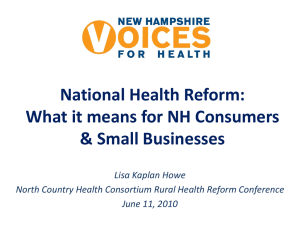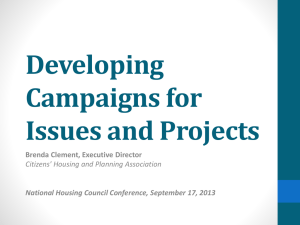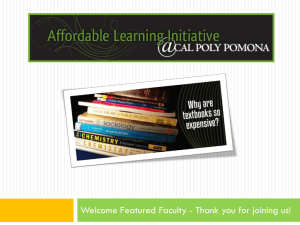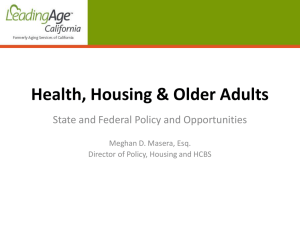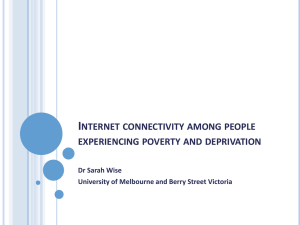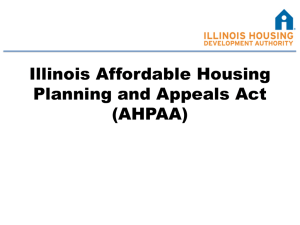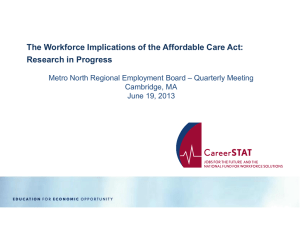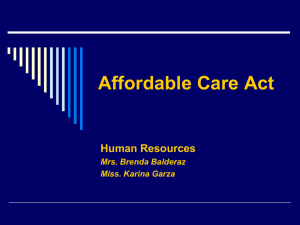Access Slides - National Housing Conference
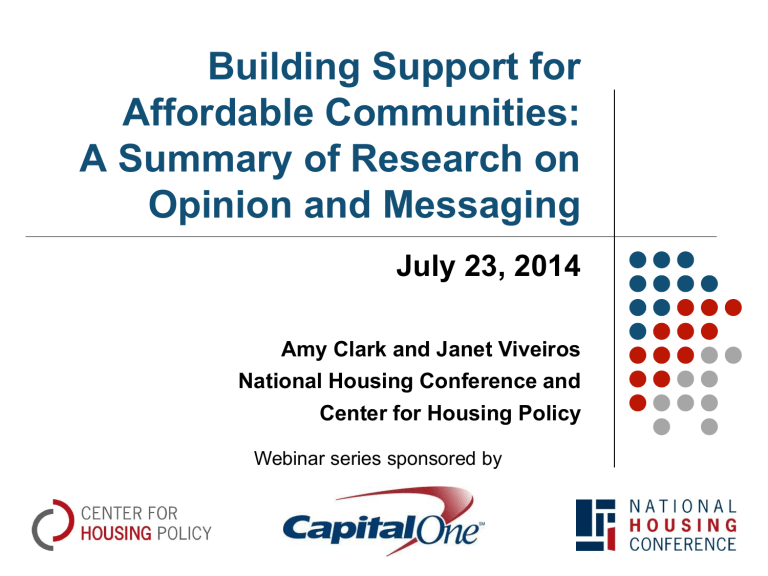
Building Support for
Affordable Communities:
A Summary of Research on
Opinion and Messaging
July 23, 2014
Amy Clark and Janet Viveiros
National Housing Conference and
Center for Housing Policy
Webinar series sponsored by
Questions & technical details
•
A link to view the presentation and download slides will be emailed to everyone who registered
•
Ask us questions via the
Questions box in your
GoToWebinar module
•
Use the Help menu or visit http://support.citrixonline.com/ for support
About the National Housing
Conference
The National Housing Conference represents a diverse membership of housing stakeholders including tenant advocates, mortgage bankers, nonprofit and for-profit home builders, property managers, policy practitioners, realtors, equity investors, and more, all of whom share a commitment to safe, decent and affordable housing for all in
America. We are the nation’s oldest housing advocacy organization, dedicated to the affordable housing mission since our founding in 1931. As a nonpartisan, 501(c)3 nonprofit, we bring together our broad-based membership to advocate on housing issues.
The Center for Housing Policy is the research division of NHC. The Center specializes in developing solutions through research, working to broaden understanding of the nation’s housing challenges and to examine the impact of policies and programs developed to address these needs. Combining research and practical, real-world expertise, the Center helps to develop effective policy solutions at the national, state and local levels that increase the availability of affordable homes.
Review of Research on Affordable
Housing Communications
Public Opinion Findings
• Housing cost issues have the most traction in high-cost areas
• Housing cost concerns are often passive and do not translate into political support
• Homeownership solutions are more attractive to the public than rental solutions
• Personal familiarity with housing challenges has increased
Language & Messaging Recommendations
• Focus on specific beneficiaries
• Describe programs in terms that affirm the beneficiaries deserve assistance
• Make clear that the whole community benefits
• Appeal to core values such as choice, hard work, balance, fairness and opportunity
Public Opinion Findings:
Housing cost issues have the most traction in high-cost areas
•
In a 2006 national survey, 14 percent of working families identified housing costs as the single most worrisome economic challenge, behind gasoline/energy costs (41 percent) and health care costs (19 percent).
•
Segmented by housing market, 28 percent of respondents in higher-cost markets selected housing costs as the most worrisome challenge, compared with only 10 percent in lower-cost markets.
Housing cost issues have the most traction in high-cost areas
•
An annual national survey on attitudes towards homeownership found that worries about housing affordability have declined significantly since 2005 when home prices were at their peak.
•
A 2010 survey conducted determined that 82 percent of
Rhode Islanders believed the state had an “affordable housing problem” despite the drop in home prices across the state.
Leveraging public opinion:
Make numbers work for you
•
Use social math to turn abstract numbers into reality.
•
Focus on the shortage of affordable housing, not just on cost burden.
Housing cost concerns are often passive and do not translate into political support
Possible reasons why:
•
Opportunities for action are not clearly identified.
•
Levels of support for housing affordability may not be great enough to spur people to action.
•
People may support affordable housing abstractly but remain ambivalent about its impact in their community.
•
A study on the views of policymakers described their sense of “little reward and substantial risk” in taking on housing affordability-related issues.
Leveraging public opinion:
Aspirations and solutions
•
Give people something to aspire to: a community that can be a place where everyone can live, work and play, affordably.
•
Show how your community is working to get there, and how similar solutions have worked here or in other parts of the country.
•
Provide cover to elected leaders and keep the business community engaged by showing how support, action lead to results.
Homeownership solutions are more attractive to the public than rental solutions
•
In one study, 54 percent said they were comfortable with affordable homes in their neighborhood, but that number rose to 61 percent when the units are specified as homes to buy, and dropped to 39 percent for rental units.
•
In a national survey, after given information about current housing policy and the growing popularity of renting, 65 percent agreed with a statement that housing policy should focus more equally on the affordable housing needs of both homeowners and renters.
Personal familiarity with housing challenges has increased
•
In a 2012 study in Long Island, nearly 6 in 10 reported they
“have at least some difficulty paying their rent or mortgage.”
•
A national survey found that 35 percent of respondents felt
“resentful that it [government assistance] could help borrowers who took out mortgages they weren’t certain they could pay.”
Personal familiarity with housing challenges has increased
•
It is unclear how this resentment affects attitudes about affordable housing initiatives in general, but it does suggest that it might be difficult to turn widespread personal experience with housing cost challenges into support for affordable housing initiatives.
Leveraging public opinion:
The language of “us”
•
Affordable housing benefits the entire community, so let’s use inclusive language to talk about it.
•
Collective language can lead us to systemic thinking, community solutions.
•
Use personal stories, metaphor to show how people who need affordable housing have the same aspirations as those who can afford market-rate housing.
Language and Messaging Recommendations:
Focus on Specific Beneficiaries
•
People are more likely to recognize a shortage of affordable homes when the target population is described using an income range (“households earning
$25,000 to $40,000 ”) or a qualifier
(“young families just starting out ”).
Messages that work:
Local and regional narratives
•
Be explicit about the wages earned by community workers, the housing those wages affords.
•
Leverage local memory of a more affordable era.
•
Tell a story of what your community could be like with more affordable housing.
Describe programs with terms that affirm that the beneficiaries deserve assistance
•
The messages most likely to build support for affordable homes describe program beneficiaries with terms that affirm that they deserve assistance, such as “working families.”
Make it clear that the whole community benefits
•
In a 2009 survey in Massachusetts, almost two-thirds of the respondents reported that the lack of affordable housing harmed “the local economy” and over 70 percent agreed that high housing costs prevent young families and the elderly from living in their community.
•
A 2004 survey in Long Island found that a majority of residents believed affordable housing would negatively affect traffic congestion, school quality and property values, and generally attract the “wrong kind of people.”
Appeal to core values such as choice, hard work, balance, fairness, and opportunity
•
In discussions about gentrification, focus groups in a study agreed that people should not be forced to leave their communities due to rising housing costs.
•
Most people view housing as a consumer issue, rather than a social issue. Some researchers suggest framing the message to appeal to market-based values, such as choice, variety, and balance.
Messages that work:
Values
• The “Opportunity Frame:” Equality, community and human dignity as cornerstones of opportunity.
( http://toolkit.opportunityagenda.org/ )
Recent Research
•
How Housing Matters Survey
•
Nearly half of Americans have dealt with insecure housing at some point
•
•
Nearly 60 percent believe the federal government should invest equally in affordable rental and homeownership initiatives
A majority believe that state and local governments should do more to ensure there is a sufficient number of affordable homes to rent and buy
Messages that work:
Public structures
•
Many housing solutions require a strong role for government.
•
Collective narratives, stereotypes about government are getting in the way of a government role which can help us solve the problems in our communities.
• Framing government as a “public structure” bridges ideologies, creates space for effective advocacy.
( http://www.publicworks.org/ )
Questions?
Capital One Webinar Series
Upcoming Webinars
•
Inclusionary Upzoning
July 31, 2014, 2 p.m. - 3 p.m. EDT
•
10 Scientifically Proven Ways Advocates
Can Speak Differently and Get Results
August 12, 2014, 2 p.m. - 3 p.m. EDT
Continue the discussion on the
Housing Communications HUB
http://hub.nhc.org
Thank You!
Amy Clark
Director of Marketing &
Communications
National Housing Conference
Phone: 202.466.2121 x226
Email: aclark@nhc.org
@amysee
Janet Viveiros
Research Associate
Center for Housing Policy, a division of the National
Housing Conference
Phone: 202.466.2121 x246
Email: jviveiros@nhc.org

